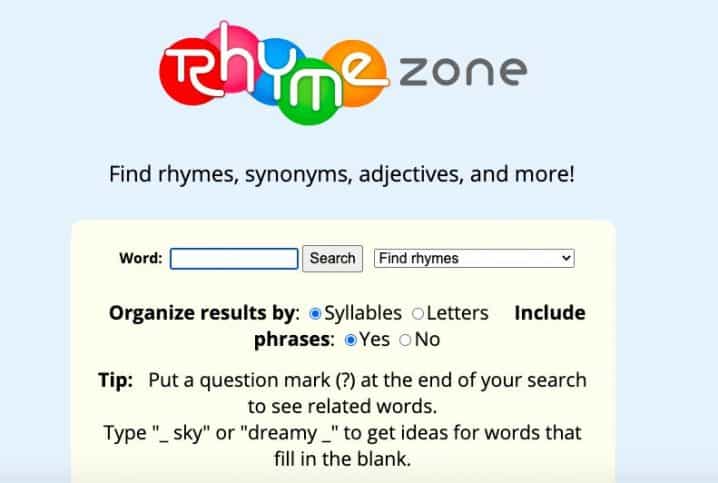
Rhymes are part of what make poems, songs, and rap so entertaining and memorable. The similar sounds at the end of lines give us a sense of stability and predictability, making the piece enjoyable to read and hear.
In order to write your own memorable lines, you should first understand the different ways you can form rhymes.
Perfect Rhymes vs. Imperfect Rhymes
Perfect rhymes (also known as a true, exact, or full rhymes) are created when two or more words end in exactly the same sound, and also share the stress (or lack of it) on the ending syllable.
For example:
- Cat and hat
- Care and share
- Forever and never
You can also make imperfect rhymes, also known as slant or off-rhymes. These happen when two or more words at the end of lines end in the same consonant but have different vowel sounds:
- Stop and pup
- Good and bad
- Best and cast
End Rhymes vs. Internal Rhymes
Rhymes can also be end rhymes or internal rhymes. End rhyme happens when the last words in two or more lines of a poem rhyme with one another. For example:
Roses are red
Violets are blue
Sugar is sweet
And so are you.
An internal rhyme happens when words within a line rhyme with each other. For example:
And he huffed, and he puffed, and he blew the house down.
How to Rhyme Words
The following tips should help you learn how to rhyme words in a poem, in rap, or in song lyrics.
1. Write the first four lines of your poem or song.
At this point, don’t worry about rhyming yet; just write four lines about your chosen topic. For example, for the theme of changes throughout the years, you might write:
The years have passed quickly by
So much has changed
Will things ever go back to the way they were?
I wish for the good old days.
2. Try ending the first line with a CVC word.
It’s usually easiest to start making perfect rhymes using one-syllable words. For this step, try to rewrite the first four lines to fit one of the easiest ways to rhyme: the use of CVC words. or three-letter words that go consonant-vowel-consonant. For example:
hat can pad day
For each CVC word you use, try changing the first letter, going from A to Z, and listing down all the combinations that form words. (This will look like a child’s phonics reading practice, but it will be good practice for you, too!)
| hat | can | pad | day |
| bat | ban | bad | bay |
| cat | Dan | dad | gay |
| fat | fan | fad | hay |
| mat | LAN | had | jay |
| Nat | man | lad | Kay |
| pat | pan | mad | lay |
| rat | ran | rad | may |
| sat | tan | sad | nay |
| tat | van | tad | pay |
| vat | wan | wad | ray |
| say | |||
| way | |||
| yay |
For this step, you might change the first line, “The years have passed quickly by” to something like this:
The years have gone, day by day
3. Change the first letter of the CVC word in the first line to make the last word of the second line.
Since the last word of your first line is the CVC word “day,” replace the letter “d” with all the letters in the alphabet. List down all that are actual words, and pick one or two that can work for the thought you want to express.
For our example, perhaps the word “say,” “may,” or “way” can work. Your first and second lines might go:
The years have gone, day by day
Changes and changes, they come my way
4. Use words ending in the same suffix.
For the third and fourth lines, try another easy way to rhyme: use words that end with the same suffix. Suffixes are parts of a word that are added to form a derivative. When you know many words ending in the same suffix, you can create rhymes of longer words without much effort.
Examples include the following:
- Verbs ending in “-ed” that is sounded out
- wanted, pointed, seated, created
- Gerunds or verbs in the present progressive tense, which ends in “-ing.”
- watching, waiting, hurting, aching, burning, bringing
- Nouns ending in the same suffix, such as “-ness,” “-ment,” “-tion”
- happiness, giddiness, godliness
- contentment, predicament,
- nation, contention, probation
- Adjectives ending in the same suffix, such as “-y,” “-er,” “-est,” or “-ful”
- happy, giddy, yummy, thirsty, hungry
- better, faster, fatter, happier
- fastest, fattest, happiest, jolliest
- joyful, wonderful, beautiful
- Adverbs ending in “-ly”
- lovely, joyfully, manfully, quickly, slowly
If you want to make the root words rhyme, that’s another challenge, but one that makes for a more musical feel:
- watching, catching, matching
- crunching, munching
- created, mated, abated
- nation, probation, creation,
Try this tactic with the third and fourth lines. You might rewrite “Will things ever go back to the way they were?” into:
Will things ever go back to those years of plenty
Then, think of another adjective that ends in the same suffix “-y.” Perhaps you might write:
When everything seemed so carefree and happy?
So from this short exercise, we converted this:
The years have passed quickly by
So much has changed
Will things ever go back to the way they were?
I wish for the good old days.
to this:
The years have gone, day by day
Changes and changes, they come my way
Will things ever go back to those years of plenty
When everything seemed so carefree and happy?
4. Consult a rhyming dictionary or an online rhyming website.
If you have trouble thinking up words on your own, don’t be afraid to use references. A rhyming dictionary sorts words according to their ending sound. If you need a word that ends in -er, the dictionary will list all the possible words you can use.

You can also use websites like Rhymezone, which lets you find the following:
- rhymes
- near rhymes
- synonyms
- descriptive words
- antonyms
- definitions
- lyrics and poems
- homophones
- similar-sounding words
- matching consonants
- related words
- similar spellings
- matched letters
- pictures
- occurrences in Shakespeare
5. Brainstorm synonyms so you can find a rhyme.
When you’re trying to find a rhyme, consider the use of synonyms. For example, if you need a word that means “joyful,” but you need it to rhyme with “plenty,” think of synonyms for the word “joyful.” This can include “happy,” which rhymes with “plenty.”
6. Try rearranging phrases.
When creating rhymes, sometimes you might want to rearrange your phrases within a line. Let’s use another example, from a poem I wrote when I was ten years old:
With all our hearts, let’s unite all nations
Hand in hand, let’s save all creation
Let’s do our share for preserving the earth
Let’s start to care for future generations.
If your goal is to have all the lines end in a rhyme, you might want to rearrange the words in the third line as follows:
With all our hearts, let’s unite all nations
Hand in hand, let’s save all creation
Let’s do our share for earth-preservation
Let’s start to care for future generations.
Alternatively, if you want the third and fourth lines to rhyme with a different sound, you might try rearranging them, like this:
With all our hearts, let’s unite all nations
Hand in hand, let’s save all creation
For earth preservation, let’s do our share
For future generations, let’s start to care.
Learning to Rhyme
Learning how to form rhymes takes a lot of practice. The more you do it, the easier it becomes. It may even become second-nature for you! This is why rappers are very adept at creating rhymes, even spontaneously, such as in rapping challenges.
Whether you want to rhyme for a poem or song lyrics, practice it as regularly as possible. Start with once a week, and work up to crafting a short rhyme, even just two to four lines everyday. For an added challenge, experiment with different kinds of poems, too, such as limericks and sonnets.
Did you find this post helpful? Let us know in the comments below!
If you enjoyed this post, then you might also like:
- Wedding Poems: The Best Poems About Love and Marriage
- 16 Poems about Friendship to Celebrate Your Bond
- How to Analyze a Poem: 8 Tips for Understanding Poetry
- Rhythm in Literature: Definition, Examples, and How to Create Your Own
Yen Cabag is the Blog Writer of TCK Publishing. She is also a homeschooling mom, family coach, and speaker for the Charlotte Mason method, an educational philosophy that places great emphasis on classic literature and the masterpieces in art and music. She has also written several books, both fiction and nonfiction. Her passion is to see the next generation of children become lovers of reading and learning in the midst of short attention spans.
